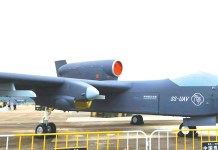Taiwan’s Army looks forward to receiving two US-made M1A2T Abrams tanks by June 30, according to reports. The handover of the two newly built tanks will take place in the US, where Taiwanese soldiers will learn to drive, fire, and maintain the armored vehicles.
US Marines’ F-35B Thwarted Attacks By Chinese-Designated Stealth Fighters In One Of The Biggest War Drills In Indo-Pacific
After training, the soldiers will return to Taiwan as instructors, the Liberty Times reported. Previous reports indicated that the self-governing island’s Army was planning to send around 84 personnel – 36 tank operators and 48 maintenance staff – to train for six to nine months in the US.
China views the island as a breakaway province, which must be reunited with the mainland, if required, by force. Amid this threat, Taipei is modernizing its military by procuring advanced weapons.
It has purchased 108 units of the Abrams to replace the second-generation M60A3 Patton and CM-11 Brave Tiger tanks that have been in service for more than two decades.
The $1.42 billion deal was approved in 2019, under which 108 Abrams tanks would be delivered in four batches between 2023 and 2026. The pact also includes Stinger missiles and other equipment.
According to the budget of the Taiwanese Ministry of National Defense, the first 38 tanks are scheduled to be delivered in 2024, followed by 42 in 2025, and 28 in 2026.
These tanks will reportedly be assigned to the 6th Army Corps, which is responsible for the security of northern Taiwan, where most central government agencies are located.
The M1A2T tanks will have better maneuverability, be able to keep up with rapid developments on the battlefield, improve the Army’s overall combat capability, and improve joint combat effectiveness and firepower, the Army Command said.
The M1A2T is a customized model of the System Enhancement Package Version 2 (SEPv2) of the Abrams main battle tank.
The M1A2 SEPv2 Abrams tank features a new-production turret with a series of improvements for enhanced survivability. It has two sights for the gunner and the commander, thus increasing the tank’s lethality by providing a hunter/killer capability. While the gunner destroys targets, the commander can simultaneously look for the next threat on the battlefield.
M1A2 is a digital tank with an electronic backbone, powerful computers, and an open architecture that allows interoperability and eases the maintenance burden while facilitating future upgrades without the need for significant redesign.
The SEPv2 Abrams tanks are equipped with a Common Remotely Operated Weapon Station (CROWS) which allows the operator to control and fire a weapon by looking at a video screen while remaining inside the vehicle under the protection of armor.
Also, these tanks are outfitted with the Israeli-made Trophy Active Protection System (APS) comprising a small number of projectiles that can destroy incoming threats – anti-tank guided missiles (ATGMs), RPGs, anti-tank rockets, and tank HEAT rounds – before they hit the vehicle.

The Abrams MBT has enhanced armor protection that can withstand nuclear, biological, and chemical (NBC) attacks. According to reports, the M1A2 has a composite 850 mm armor and is armed with a 120 mm smoothbore gun that can penetrate 850 mm rolled homogenous armor.
The tank uses an AGT-1500 gas turbine engine capable of generating 1500 horsepower, giving it the ability to rush onto the battlefield with no problem.
Tanks Are Key To Taiwan’s War Strategy
Tanks are critical to Taiwanese defense strategy against a potential Chinese invasion. If the People’s Liberation Army (PLA) troops manage to land on the island nation, the Taiwanese armored units are supposed to destroy the temporary lodgements before they can become permanent.
The PLA can fire a barrage of rockets to destroy Taiwan’s tanks before the first landing craft hit the beaches. Therefore, Taiwan’s military has identified thousands of hiding places for armored vehicles—caves, underpasses, among others.
“Taiwanese army and marine units are likely to disperse their tanks to coastal hide-sites prior to the invasion,” said Ian Easton, a Taiwan expert with the Project 2049 Institute in Virginia.
“There is an almost limitless supply of potential hiding places along Taiwan’s coast: tunnels, caves, bridge underbellies, airport hangars, and empty factories,” Easton noted.
Also, as part of the preparations for the M1A2s, the Taiwanese Army will begin to build bunkers this year to increase the survivability of the armored vehicles during a military conflict, according to military officials cited by the Liberty Times.
Furthermore, expansion and renovation work on two combat vehicle training grounds in Chang’an Camp and Kengzikou will also begin this year. The total cost of the three projects exceeds NT$2.5 billion (US$87.49 million).
According to Liberty Times, the Ministry of National Defense has already awarded a contract for the Kengzikou ground construction project. The first phase of the work is expected to start this week.
- Written by Tanmay Kadam/EurAsian Times Desk
- Contact the author at etdesk@eurasiantimes.com
- Follow EurAsian Times on Google News




